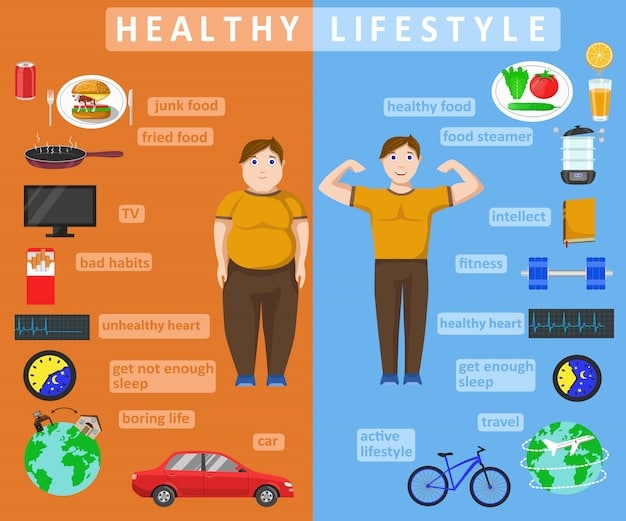HIIT vs. LISS: Maximize Fat Burn in 30 Days

While both High-Intensity Interval Training (HIIT) and Low-Intensity Steady State (LISS) cardio can contribute to fat loss, the optimal choice depends on individual fitness levels, time constraints, and preferences, as effectiveness varies significantly over a 30-day period.
Deciding between HIIT vs. LISS: Which Cardio Strategy Burns More Fat in 30 Days? can be a game-changer in your fitness journey. Both methods offer distinct advantages, but understanding how they affect your body and metabolism is key to achieving your fat loss goals.
Unveiling HIIT: The High-Intensity Challenger
High-Intensity Interval Training, or HIIT, has gained immense popularity for its efficiency and effectiveness. It involves short bursts of intense exercise followed by periods of rest or lower-intensity activity. Let’s delve into the core principles and benefits of HIIT.
The Science Behind HIIT
HIIT leverages the body’s anaerobic system, pushing you to your maximum effort for short durations. This leads to an “afterburn effect,” scientifically known as Excess Post-exercise Oxygen Consumption (EPOC), where your body continues to burn calories at a higher rate even after the workout is over.
Benefits of HIIT
Besides the impressive calorie burn, HIIT offers a range of other benefits. These include improved cardiovascular health, increased insulin sensitivity, and enhanced muscle endurance. It is also a great way to improve your VO2 max, a measure of your body’s ability to use oxygen during exercise.
- Time-efficient workouts fitting into even the busiest schedules.
- Significant calorie burn during and after the exercise session.
- Improved cardiovascular health and endurance.
- Potential for muscle growth and retention when combined with strength training.
In summary, HIIT is a powerful tool for fat loss and overall fitness, especially when time is of the essence. However, it is essential to consider potential drawbacks, such as the higher risk of injury and the need for adequate recovery.
Exploring LISS: The Low-Intensity Endurance Approach
Low-Intensity Steady State (LISS) cardio, as the name implies, involves maintaining a consistent, low-intensity effort for a sustained period. Activities like walking, jogging, cycling, or swimming at a moderate pace fall under this category. Let’s explore the nuances of LISS and its contribution to fat loss.
The Mechanics of LISS
LISS primarily engages the aerobic system, utilizing fat as a primary fuel source during exercise. This contrasts with HIIT, which relies more on carbohydrate stores for energy. By maintaining a lower intensity, LISS allows you to exercise for longer durations, leading to a significant cumulative calorie expenditure.
Benefits of LISS
LISS offers several advantages, particularly for beginners or individuals with joint issues. It is gentler on the body, reducing the risk of injury and making it a sustainable option for long-term fitness. Moreover, LISS can be a relaxing and meditative form of exercise, promoting mental well-being.
- Lower impact on joints, making it suitable for individuals with injuries or limitations.
- Sustainable for longer durations, maximizing calorie expenditure.
- Improved cardiovascular health and endurance.
- Stress reduction and mental well-being benefits.
LISS is a valuable option for those seeking a lower-impact, sustainable approach to fat loss and overall fitness. Its versatility and accessibility make it an excellent choice for individuals of all fitness levels and backgrounds.

Calorie Burning Face-Off: HIIT vs. LISS
When it comes to calorie expenditure, both HIIT and LISS can be effective strategies. However, the amount of calories burned depends on various factors, including intensity, duration, individual metabolism, and body composition. Let’s analyze and compare the calorie-burning potential of each method.
HIIT: Calorie Inferno
HIIT workouts typically burn a significant amount of calories in a short amount of time, thanks to their high-intensity nature. Moreover, the afterburn effect (EPOC) continues to elevate calorie expenditure for hours after the workout, potentially leading to a higher overall calorie deficit. Studies suggest HIIT can burn 25-30% more calories than other forms of exercise.
LISS: Steady and Consistent Burn
LISS cardio, on the other hand, burns fewer calories per minute compared to HIIT. However, the ability to sustain LISS for longer durations can result in a substantial calorie burn over time. A 60-minute LISS session can burn a comparable number of calories to a shorter HIIT workout, especially for individuals who can’t tolerate high-intensity exercise.
Ultimately, the choice between HIIT and LISS for calorie burning depends on individual preferences, fitness levels, and time constraints. Both methods can contribute to a calorie deficit, which is essential for fat loss, but the most effective strategy is the one that you can consistently adhere to and enjoy.
Fat Loss Showdown: Which Strategy Wins in 30 Days?
While calorie expenditure is an important factor in fat loss, it is not the only determinant. The type of fuel your body uses during exercise, hormonal responses, and metabolic adaptations also play crucial roles. Let’s examine how HIIT and LISS impact fat loss specifically over a 30-day period.
HIIT: Targeting Stubborn Fat
HIIT has been shown to be particularly effective at targeting visceral fat, the dangerous fat stored around abdominal organs. The high-intensity bursts during HIIT workouts trigger a greater release of hormones like epinephrine and norepinephrine, which promote fat breakdown and mobilization.
LISS: Sustained Fat Utilization
LISS cardio, due to its lower intensity and longer duration, encourages the body to utilize fat as a primary fuel source during exercise. This can lead to a gradual but consistent reduction in overall body fat percentage over time. Because it’s easier on the body, LISS can be performed more frequently, promoting a sustained fat-burning environment.
- HIIT may be superior for targeting stubborn visceral fat due to hormonal responses.
- LISS promotes steady fat utilization and overall body fat reduction.
- The best strategy depends on individual responses and adherence.
The winner of the fat loss showdown depends on individual circumstances and preferences. HIIT may offer faster results in terms of visceral fat reduction, while LISS provides a sustainable approach for overall body fat loss.

Individual Factors: Choosing the Right Cardio for You
When deciding between HIIT and LISS, it is essential to consider your individual factors, such as fitness level, goals, preferences, and any pre-existing health conditions. What works for one person may not be suitable or effective for another. Let’s assess the key factors that can influence your choice.
Fitness Level
HIIT requires a certain level of fitness and conditioning to perform the high-intensity bursts safely and effectively. Beginners or individuals with underlying health conditions should start with LISS cardio and gradually progress to HIIT as their fitness improves. Otherwise, the risk of injury may outweigh the benefits.
Personal Goals
If your goal is to improve cardiovascular fitness, increase VO2 max, and build endurance, both HIIT and LISS can be beneficial. However, HIIT may offer a more time-efficient approach to achieving these goals. If your primary focus is on fat loss and overall well-being, LISS may be a more sustainable and enjoyable option.
Preferences and Enjoyment
Ultimately, the most effective cardio strategy is one that you enjoy and can consistently adhere to. If you find HIIT to be too intense or stressful, you are less likely to stick with it in the long run. Similarly, if you find LISS to be boring or monotonous, you may struggle to stay motivated.
Consider your personal preferences, past experiences, and any physical limitations when choosing between HIIT and LISS. The best approach is one that you can incorporate into your lifestyle and consistently maintain over time.
Combining HIIT and LISS: The Best of Both Worlds?
Instead of choosing one over the other, consider incorporating both HIIT and LISS into your fitness routine. This approach can provide a well-rounded workout plan that maximizes the benefits of both methods. Let’s explore the advantages of combining HIIT and LISS.
Variety and Balance
Combining HIIT and LISS can add variety and balance to your training schedule, preventing boredom and plateaus. You can alternate between HIIT sessions on some days and LISS sessions on others, or even incorporate both into the same workout. This approach can challenge your body in different ways and optimize your results.
Optimizing Recovery
HIIT workouts require adequate recovery time to allow your muscles to repair and rebuild. LISS cardio can be used as a form of active recovery on your off days, promoting blood flow and reducing muscle soreness. This can help you bounce back faster from your HIIT sessions and stay consistent with your training.
- Combining HIIT and LISS offers a balanced approach to fitness.
- It prevents boredom, plateaus, and optimizes recovery.
- Finding the right balance is key to maximizing results and minimizing injury risk.
Consider experimenting with different combinations of HIIT and LISS to find what works best for you. You may find that incorporating both methods into your routine provides a synergistic effect, leading to greater fat loss, improved fitness, and overall well-being.
| Key Point | Brief Description |
|---|---|
| 🔥 HIIT Benefits | Efficient calorie burn, improves cardio, targets visceral fat. |
| 🚶 LISS Benefits | Low impact, sustainable, promotes overall fat loss, stress reduction. |
| ⚖️ Individual Choice | Fitness level, goals, and preferences dictate the best approach. |
| 🔄 Combining Both | Offers variety, optimizes recovery, maximizes overall benefits. |
Frequently Asked Questions
▼
HIIT can be intense, so beginners should start with shorter intervals and longer recovery periods. Consulting a fitness professional is recommended before starting HIIT.
▼
LISS can be performed more frequently than HIIT, even daily, as it is less taxing on the body. Aim for at least 30 minutes per session for optimal results.
▼
Yes, LISS can contribute to weight loss when combined with a healthy diet. It’s a sustainable way to burn calories and maintain a consistent fitness routine.
▼
While not its primary function, HIIT can stimulate some muscle growth, especially when combined with strength training exercises. It mainly enhances muscle endurance.
▼
Both HIIT and LISS have their places in a comprehensive fitness plan. The best approach is one that fits your lifestyle and you can maintain consistently over time.
Conclusion
Ultimately, the debate of HIIT vs. LISS: Which Cardio Strategy Burns More Fat in 30 Days? comes down to individual preferences, fitness levels, and goals, but combining them strategically may yield the best overall results.





